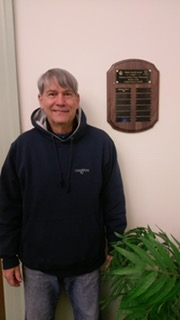The first Mary Mortensen Public Health Award Ceremony was held at Ashland Town Hall on March 20. This year Ashland resident Ed Hart was honored as the first recipient of the award in acknowledgement of his dedication to the Cadilac Paint cleanup project and his many contributions as a member of the Board of Health and other Ashland boards and committees throughout the years.
Jon Fetherston, Board of Health (BOH) vice chair, explained how the award came to be: “When Mary passed [in January 2018], I went to the other BOH members with the idea of creating an award to honor her legacy in town for her years of service on the BOH, Ashland Emergency Fund and the Ashland Fire Department. I was a big fan of Mary. I always respected her can-do attitude, how she always helped others, quietly and in a caring way. She was a devoted volunteer and public servant.
“Mary was a heavy smoker but worked hard to change the tobacco laws in town, when we were told we couldn’t, and in the state, so others would not suffer from smoking the way she did.
“I thought this award would be a nice way to honor her contributions to the town. I created guidelines for the honor. Every March, the board will nominate a public health award winner. The nominee can be a state, or local—preferably—public health official or volunteer with a proven track record for making a difference in Ashland.
“We agreed on Ed Hart, a former BOH member and on the Cadilac Paint Committee since 2005. The Cadilac Paint site is finally being cleaned up and turned into a park. Ed played a large role in completing this project and was also a critical BOH member in reforming the tobacco and pesticide bylaws in town. He is also one of the nicest people in town. Always willing to help!”
The Colonial Lacquer and Chemical Company, known as The Cadilac Paint site, is located at 409 Eliot St. on approximately 2.89 acres. The company produced commercial paints and sealants, many of which were used by the U.S. military. Ed Hart and neighbors have worked on cleaning up the site for over 20 years.
Learn more about Mary Mortensen: https://livestream.com/WACA-TVAshland/events/7772013/videos/172032927.
Interview with BOH award recipient, Ed Hart
Q: How do you feel about being the first winner of the Mary Mortensen Public Health Award?
Hart: As you know, the award was created to honor the memory of one of Ashland’s great volunteers and longtime public servants, Mary ‘Penny’ Mortensen. Mary’s dedication to public health is well known and, as a friend and co-worker with Mary, it pleases me to see her efforts honored in this way. Mary’s endless work to improve and secure the health and wellness of our community is the model for which this award was created, and I am humbled to be its first recipient.
Q: Why did you get involved in the project?
Hart: I first started working to clean up Cadilac Paint and remove the buildings back in the mid 1990s. The exact date I don’t recall, but it all started as a neighborhood effort and a demonstration against an attempt to re-introduce an industrial use onto the site. I created a newsletter and named it “Clean and Green,” and proceeded to inform all residents of the surrounding area of the levels of pollution, the progress taken to clean up the site and the possible alternatives for its future use. I have been a neighbor of Cadilac Paint since 1991. My father used to say that a person should first work to fix what is right in front of them before they try to tackle other more distant issues.
Q: What is the background of the project?
Hart: The paint company operated on that site from 1938 to 1985 when it ceased operations and remediation began. Since 1985, the site has been the subject of clean-up by over a dozen different environmental engineering companies, as well as soil remedial actions taken by the EPA [U. S. Environmental Protection Agency] in 2015.
In order for the state to allow this property to be used for any public purpose, it needs to qualify and meet very strict Massachusetts Contingency Plan standards. In other words, it needs to be as clean—or cleaner—than your front or backyard. Otherwise, no public use will happen on that land.
Q: Where does the project stand now?
Hart: I understand that over the next 4 to 6 weeks all the buildings will be removed and the last details of remediation, which are very slight, will be completed. The town has taken ownership of the property.
In the past, the general consensus among the areas residents has been to see some type of neighborhood park. Although nearly everyone agrees that just seeing the buildings removed is satisfaction enough, replacing the negative environmentally harmful paint factory with something attractive and positive, such as a walking park or pollinator garden, would be an improvement that helps the people, the property values and the reputation of the town.
Q: What has been most frustrating? Most fulfilling?
Hart: The most frustrating part of this 25-year ordeal has been the waiting. The town, the state, the owners and the residents all wanted to fix this problem and return the land to its clean and natural state, but the lack of money to apply to remediation prevented everyone involved from solving the problem quickly. I am sure that experiences like the history of Cadilac Paint will serve as a lesson to this and other towns that planning and zoning have to be well thought out and heavily regulated with a focus toward putting public health and residential property values ahead of commercial profit.
As to the most fulfilling part of this: seeing that first building being torn down was worth all the work it took to get here.
© Copyright by Cynthia Whitty, April 2018

